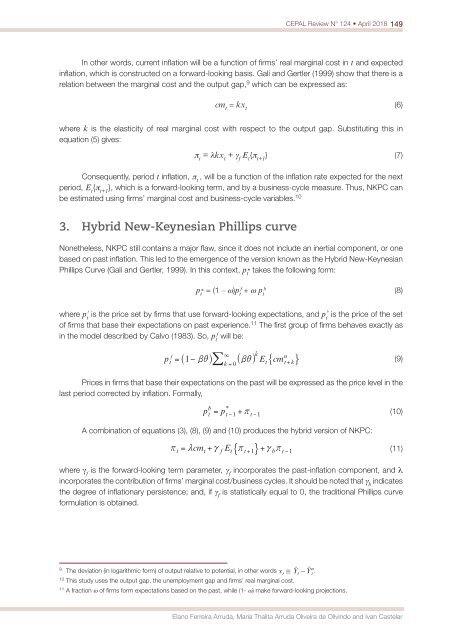CEPAL Review no. 124
April 2018
April 2018
Create successful ePaper yourself
Turn your PDF publications into a flip-book with our unique Google optimized e-Paper software.
<strong>CEPAL</strong> <strong>Review</strong> N° <strong>124</strong> • April 2018 149<br />
In other words, current inflation will be a function of firms’ real marginal cost in t and expected<br />
inflation, which is constructed on a forward-looking basis. Galí and Gertler (1999) show that there is a<br />
relation between the marginal cost and the output gap, 9 which can be expressed as:<br />
cm t<br />
= kx t<br />
(6)<br />
where k is the elasticity of real marginal cost with respect to the output gap. Substituting this in<br />
equation (5) gives:<br />
p t<br />
= lkx t<br />
+ g f<br />
E t<br />
{p t+1<br />
} (7)<br />
Consequently, period t inflation, p t<br />
, will be a function of the inflation rate expected for the next<br />
period, E t<br />
{p t+1<br />
}, which is a forward-looking term, and by a business-cycle measure. Thus, NKPC can<br />
be estimated using firms’ marginal cost and business-cycle variables. 10<br />
3. Hybrid New-Keynesian Phillips curve<br />
Nonetheless, NKPC still contains a major flaw, since it does <strong>no</strong>t include an inertial component, or one<br />
based on past inflation. This led to the emergence of the version k<strong>no</strong>wn as the Hybrid New-Keynesian<br />
Phillips Curve (Galí and Gertler, 1999). In this context, p t<br />
* takes the following form:<br />
p t<br />
* = (1 – w)p t<br />
f<br />
+ w p t<br />
b<br />
(8)<br />
f<br />
b<br />
where p t<br />
is the price set by firms that use forward-looking expectations, and p t<br />
is the price of the set<br />
of firms that base their expectations on past experience. 11 The first group of firms behaves exactly as<br />
in the model described by Calvo (1983). So, p<br />
f<br />
t<br />
will be:<br />
(9)<br />
Prices in firms that base their expectations on the past will be expressed as the price level in the<br />
last period corrected by inflation. Formally,<br />
A combination of equations (3), (8), (9) and (10) produces the hybrid version of NKPC:<br />
where γ f<br />
is the forward-looking term parameter, g f<br />
incorporates the past-inflation component, and λ<br />
incorporates the contribution of firms’ marginal cost/business cycles. It should be <strong>no</strong>ted that g b<br />
indicates<br />
the degree of inflationary persistence; and, if g f<br />
is statistically equal to 0, the traditional Phillips curve<br />
formulation is obtained.<br />
(10)<br />
(11)<br />
9<br />
The deviation (in logarithmic form) of output relative to potential, in other words .<br />
10<br />
This study uses the output gap, the unemployment gap and firms’ real marginal cost.<br />
11<br />
A fraction w of firms form expectations based on the past, while (1- w) make forward-looking projections.<br />
Ela<strong>no</strong> Ferreira Arruda, Maria Thalita Arruda Oliveira de Olivindo and Ivan Castelar


















